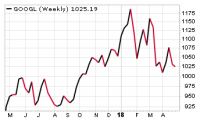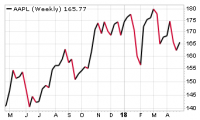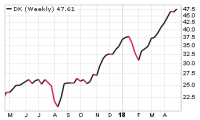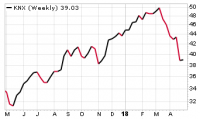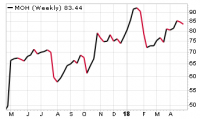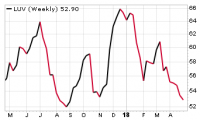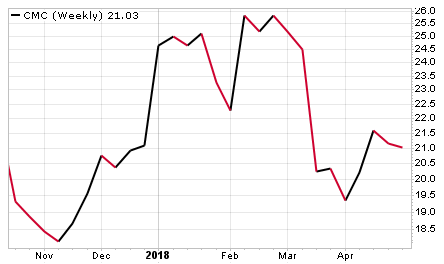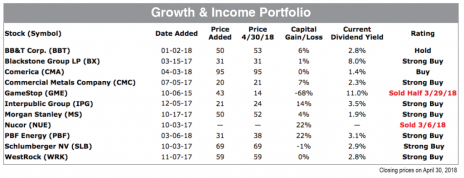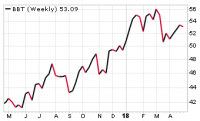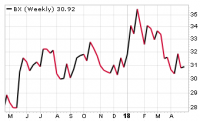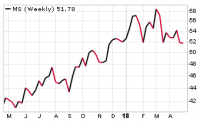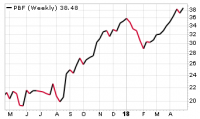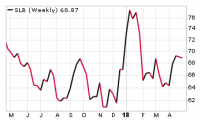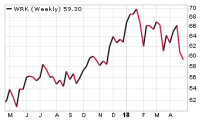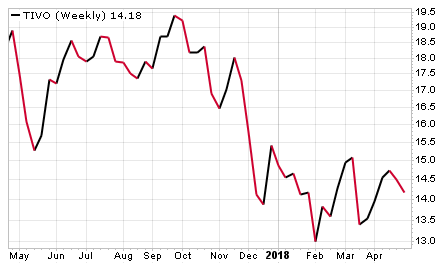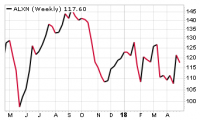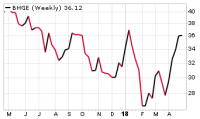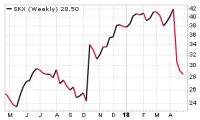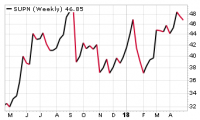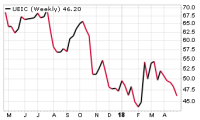There’s quite a bit of discussion on stock market trends pertaining to energy stocks, financial stocks and takeover stocks.
Cabot Undervalued Stocks Advisor 518
[premium_html_toc post_id="149412"]
Stock Sector and Industry Trends
Energy stocks experienced lots of bullish price action in recent weeks. I expect most of them to pause in their uptrends, and that could include pullbacks, which would be perfectly normal. Use the pullbacks to add to your favorite energy stocks.
Yesterday, Marathon Petroleum (MPC) announced that it will acquire Andeavor (ANDV)—both are oil refining companies. As a result, the two oil refining companies in the Cabot Undervalued Stocks Advisor portfolios—Delek US Holdings (DK) and PBF Energy (PBF)—rose again in reaction to the possibility of further consolidation within the sector.
Delek and PBF are tiny companies compared to Marathon, Andeavor, and two other industry leaders: Valero Energy (VLO) and Phillips 66 (PSX). All four of those larger companies have been on my “waiting in the wings” stock list because they have fantastic fundamentals, but I can’t load up our stock portfolios with half a dozen oil refining companies, so I went with the two smaller companies. (I’m fairly certain that I’ve recommended all six of these companies in various publications during the last two years. Please contact me with any questions you might have about stocks in this industry.)
Speaking of energy stocks, our two oilfield service companies – Baker Hughes, a GE co. (BHGE) and Schlumberger (SLB) – are finally seeing good price action. Barring a disruption in the broader stock market, I definitely expect more capital appreciation from these two stocks this year. Don’t be surprised, however, if the stocks have pullbacks before continuing their uptrends.
As you recall, I sold ConocoPhillips (COP) quite recently. I still plan to add one or two oil and gas exploration & production (E&P) companies to the portfolios, as soon as they have pullbacks.
We’re fully weighted in financial stocks, yet I’d like to add some smaller banks to capitalize on potential M&A activity in the sector that could result from pending legislation. I’m looking to sell Bank of American (BAC) and BB&T Corp. (BBT) when they retrace recent high prices, in order to make room for small and regional banks.
There are additional opportunities within the financial sector. We experienced M&A activity in the property & casualty (P&C) insurance arena this year when XL Group (XL) agreed to merge with AXA SA. Remember, XL Group was approached by several potential acquirers, meaning there’s a strong general interest in buying small, financially sound P&C companies this year. (I’ve certainly noticed that M&A activity tends to concentrate itself within specific industries at various points in time. We experienced that when two chemical companies in the Cabot Undervalued Stocks Advisor portfolios agreed to be acquired in 2016.) Thus, my intention on adding a small bank to the portfolio might get sidetracked if any particular P&C growth stock is trading at a more attractive point on its price chart.
A contrarian word of caution: I keep reading comments from investment professionals and news media that the U.S. is in a late stage of the economic cycle, with the implication that we’re about to see GDP growth slow dramatically, or even enter a recession. I find such comments so absurd that I don’t even know where to start in tearing them apart, and I’m frankly not inclined to waste time arguing against such silliness. I’ll make a few brief points, though.
The Federal Reserve would not be raising interest rates two-to-four times per year if GDP numbers were anywhere near plateauing or declining. Corporate America is going through a phenomenal phase of multi-year earnings growth, with strong earnings projections continuing several years forward. Granted, those projections belong to the stocks that I follow, and not to the broader market. However, I’m very familiar with what’s normal and what’s extraordinary within the group of stocks that meet my investment criteria. At this moment, there are far more stocks that meet my investment criteria than normal; and more of them that are expected to continue achieving double-digit earnings growth for several years to come.
I realize that if you’re looking for warnings about recessions and bear markets, you can find those warnings literally everywhere. But unless they have some sort of logical foundation reflecting a slower economy, slower corporate earnings growth, or rampant high price/earnings ratios (P/Es), my suggestion is that those warnings land in the category of “wishful thinking” on the part of bears. So relax. When the economy slows, it will be reflected in obvious numbers. We won’t have to guess whether it’s on our doorsteps. It’ll be waving a big red flag as it approaches from far down the road.
Send questions and comments to crista@cabotwealth.com.
Portfolio Notes
Be sure to review the Special Bulletins from April 26, 27 and 30 in which I mentioned news, rating changes and/or price action on Alexion Pharmaceuticals (ALXN), Baker Hughes, a GE co. (BHGE), Chipotle Mexican Grill (CMG), KLX Inc. (KLXI), Knight-Swift Transportation (KNX), Molina Healthcare (MOH) and Southwest Airlines (LUV).
Quarterly Earnings Release Calendar
May 1 p.m.: Apple (AAPL) – 2Q
May 3 a.m.: PBF Energy (PBF) and Quanta Services (PWR) – 1Q
May 3 p.m.: Universal Electronics (UEIC) – 1Q
May 7 p.m.: Delek US Holdings (DK) – 1Q
May 10 p.m.: TiVo (TIVO) – 1Q
Virtually all companies offer extensive information on their websites pertaining to their quarterly earnings releases, often including slide shows or webcasts.
Earnings Season Scorecard
Big Earnings Beat: Alexion Pharmaceuticals (ALXN), Alphabet (GOOGL), BB&T Corp. (BBT), Baker Hughes, a GE company (BHGE), Bank of America (BAC), Blackstone Group (BX), Chipotle Mexican Grill (CMG), Knight-Swift Transportation (KNX), Molina Healthcare (MOH), Morgan Stanley (MS) and PulteGroup (PHM)
Slight Earnings Beat: Comerica (CMA), Schlumberger (SLB), Skechers (SKX) and Southwest Airlines (LUV)
Slight Earnings Miss: The Interpublic Group of Companies (IPG) and WestRock (WRK)
Big Earnings Miss: CIT Group (CIT)
Buy-Rated Stocks Most Likely* To Rise More Than 5% Near-Term:
CIT Group (CIT)
Schlumberger (SLB)
*I can review price charts and make an educated determination about what’s likely to occur, but I will sometimes be wrong. I cannot control the stock market; I can only guide you through it.
Today’s Portfolio Changes:
D.R. Horton (DHI) joins the Growth Portfolio as a Strong Buy.
PBF Energy (PBF) moves from the Buy Low Opportunities Portfolio to the Growth & Income Portfolio.
Last Week’s Portfolio Changes:
Baker Hughes, a GE co. (BHGE) moved from Strong Buy to Buy.
Bank of America (BAC) moved from Strong Buy to Hold.
Chipotle Mexican Grill (CMG) was sold from the Buy Low Opportunities Portfolio.
Delek US Holdings (DK) moved from Strong Buy to Hold.
Knight-Swift Transportation (KNX) moved from Hold to Strong Buy.
Molina Healthcare (MOH) moved from Strong Buy to Hold.
Growth Portfolio
Growth Portfolio stocks have bullish charts, strong projected earnings growth, little or no dividends, low-to-moderate P/Es (price/earnings ratios) and low-to-moderate debt levels.
Featured Stock: D.R. Horton (DHI - yield 1.1%)
D.R. Horton is America’s largest homebuilder, based in Ft. Worth, TX and operating in 26 states. Since 2002, D.R. Horton has built more homes annually than any other U.S. homebuilder. The company serves a diverse audience, building homes ranging in price from $100,000 to over $1 million. The company also provides mortgage, insurance and title services.
Homebuilding companies are thriving due to strong demand vs. a dearth of properties available for resale across the U.S. Consensus earnings estimates for D.R. Horton have been rising all year. After achieving 16.9% earnings growth in 2017 (September year-end), D.R. Horton is expected to see EPS grow 32.9% and 19.8% in 2018 and 2019. Price/earnings ratios (P/E) remain low at 12.3 and 10.2 for fiscal 2018 and 2019.
The long-term debt-to-capitalization ratio has remained below 30% since 2015. That’s an important consideration, because it’s common for real estate-oriented businesses to maintain high debt levels that increase the risk associated with stock investing.
The company raises its dividend payout annually in the fourth quarter. The last three dividend increases ranged from 25% to 27%. The current yield is 1.1%.
Most homebuilder stocks experienced huge capital appreciation in 2017, followed by exaggerated pullbacks when the 2018 U.S. stock market correction arrived. DHI peaked in January near 53, so that’s my first price target, offering new investors a 17% potential short-term profit as the stock retraces recent highs. After homebuilder stocks rise to their recent highs and rest a bit, I anticipate holding DHI and/or PulteGroup (PHM)—another homebuilder in the Growth Portfolio—for additional capital gains later this year. Buy DHI now. Strong Buy.
Updates on Growth Portfolio Stocks
Alphabet Cl. A (GOOGL) is the world’s largest internet company. Revenue is derived from Google’s online ads, with the balance coming from the sale of apps, digital content, services, licensing and hardware. Subsequent to Alphabet’s first quarter earnings report, analysts revised their full-year earnings estimates. Very strong 2018 earnings growth will give way to single-digit earnings growth in 2019. The market doesn’t blink when companies like Procter & Gamble (PG) deliver single-digit earnings growth, but it scowls when FANG favorites see their earnings growth slow dramatically. The share price will almost always react negatively to prospects of slow earnings growth, but don’t worry, it’s early yet. The market will be focused on 2018 numbers well into the third quarter, so we have plenty of time to trade out of GOOGL when it nears 1,190. Hold.
Apple (AAPL – yield 1.5%) manufactures a wide range of popular communication and music devices. Apple is expected to report second quarter EPS of $ 2.68, within a range of $2.51 to $2.80, on the afternoon of May 1. Read this Forbes article that recounts recent Wall Street worries about iPhone X second quarter revenue: The Best Argument For An Upside Surprise From Apple On Tuesday. For a more comprehensive preview of what Apple’s quarter might look like, read this article from MarketWatch: Apple earnings: iPhone expectations are down, but anxiety is still high. As long as full-year earnings estimates remain strong, my outlook for the stock remains bullish, despite any interim volatility.
In conjunction with the announcement of first quarter results, investors are anticipating larger-than-usual increases to the dividend and to the share repurchase authorization due to the benefits of U.S. tax reform. Last year’s dividend increase was 10.5%. One major Wall Street firm is estimating up to a 50% dividend increase.
Apple is an undervalued growth stock, expected to see EPS increase 23.7% in fiscal 2018 (September year-end), while the P/E is comparatively low at 14.3. AAPL is very low within its recent trading range. The May 1 earnings report is going to determine whether the stock rebounds or turns bearish in the coming months. Strong Buy.
Bank of America (BAC – yield 1.6%) has seen its consensus earnings estimates rising gradually throughout April. At this point, EPS growth rates are projected to be 40.4% and 12.8% in 2018 and 2019. The corresponding P/Es are 11.7 and 10.4. BAC appears ready to rise toward its recent high near 33. At that point, we’ll have achieved a total return of 39% since BAC joined the Growth Portfolio in June 2017. I will likely sell in favor of a small bank or property & casualty insurance company. Hold.
CIT Group (CIT – yield 1.2%) operates both a bank holding company and a financial holding company that provide financing, leasing and advisory services to small and middle market businesses, consumer markets, and the real estate and railroad industries. Last week, CIT announced its intention to purchase $500 million of its common stock via a modified Dutch auction within a range of $50 to $56 per share. The offer expires May 23. (The price chart is moderately short-term bullish, and the stock could reach $56 on its own within the time frame of the Dutch auction.) My suggestion is to hold CIT for future capital appreciation. However, if you’re planning to sell shares, would like to take a chance at selling at a price that’s higher than the current market price, and you don’t mind waiting several weeks to find out whether this “name your price” offer will be accepted, then go for it.
Earnings estimates changed for CIT Group last week, with the 2018 number falling and the 2019 number rising. Analysts now expect EPS to grow 27.0% and 25.4% in 2018 and 2019. The corresponding P/Es are quite low at 13.7 and 10.9. I expect CIT to rise to its March high at 56 in the short term, with additional capital gains in 2018. Strong Buy.
Delek US Holdings (DK – yield 1.6%) is a diversified downstream energy company and a very undervalued small-cap stock. The company is expected to report first quarter earnings per share of (-$0.13) on the afternoon of May 7, within a range of (-$0.23) to $).06. Full-year earnings estimates for Delek rose dramatically in April. Analysts now expect EPS to grow 164% and 25.7% in 2018 and 2019. The corresponding P/Es are quite low at 15.7 and 12.5. DK could appeal to investors who have a focus on value, growth or dividend income. DK has been rising for 11 weeks. It’s going to need to rest soon. Afterwards, I’ll be ready to buy again. Hold.
KLX Inc. (KLXI) is a small-cap aggressive growth stock in the aerospace and energy service industries. Please refer to the Special Bulletin from April 27 that described Boeing’s (BA) potential acquisition of KLX. I’ll issue another Special Bulletin as soon as a buyout offer is solidified. Shareholders should Hold their shares for now, and be prepared to sell within days or weeks after the buyout offer emerges. Hold.
Knight-Swift Transportation Holdings (KNX – yield 0.6%) is a truckload carrier formed from the September 2017 merger between Knight Transportation and Swift Transportation Company. Subsequent to last week’s first quarter earnings beat, five investment firms changed their price targets on KNX, within a range of 45 to 63. Analysts expect full-year EPS to grow 65.2% and 20.2% in 2018 and 2019. The corresponding P/Es are 17.1 and 14.2.
KNX is an undervalued mid-cap stock. The stock fell in recent weeks, and will likely bounce here at medium-term price support at 38-39. The current price represents a tremendous buying opportunity for patient investors who are willing to wait several months for the stock to rebound to its 2018 high at 50. Strong Buy.
Martin Marietta Materials (MLM – yield 0.9%) is a supplier of crushed stone, sand, gravel, cement, concrete and asphalt. The company is expected to report $0.33 first quarter EPS in early May, within a range of $0.05 to $0.69. Expect volatility. Consensus estimates point to full-year EPS growth of 18.7% and 24.6% in 2018 and 2019. The corresponding P/Es are 23.0 and 18.5, making the stock undervalued based on 2019 numbers. MLM has been resting at price support near 200. Strong Buy.
Molina Healthcare (MOH) is a managed healthcare operator that offers health information management solutions to nearly five million members who receive their care through Medicaid, Medicare, health insurance exchanges and other government-funded programs in fifteen states. Molina reported a huge upside earnings surprise yesterday, which I outlined in a Special Bulletin. I plan to sell if the share price surges past 92 in the coming days, rather than watch the stock linger until May 22 when the company receives news on Washington State contract wins or losses. Hold.
PulteGroup (PHM – yield 1.2%) is a U.S. homebuilder and a very undervalued aggressive growth stock. Subsequent to last week’s earnings report, three investment firms raised their price targets on PHM to a range of 36 to 40, and Raymond James raised their rating to Outperform. Consensus earnings estimates jumped, now reflecting 59.7% and 12.5% EPS growth in 2018 and 2019. The corresponding P/Es are 9.4 and 8.4. Barron’s published a stock review on April 28: “The housing market continues to remain strong despite moderate increases in interest rates, offset by low unemployment and strong demographics. This bodes well for home builders in general and specifically for Pulte, as the company is focused on measured growth and production efficiencies to drive down costs.”
PHM is rebounding from a big 2018 price correction experienced by most of its homebuilding peers. (After their huge 2017 run-ups, the extended pullback is not surprising.). Buy PHM now for 14% upside on the rebound, and additional capital gains thereafter. Strong Buy.
Quanta Services (PWR) provides specialized infrastructure and network services to the electric power, oil and natural gas industries. The company is expected to report $0.32 first quarter EPS on the morning of May 3, within a range of $0.27 to $0.46. PWR is an undervalued mid-cap growth stock. Full-year consensus earnings estimates reflect 29.9% and 18.8% EPS growth in 2018 and 2019. The corresponding P/Es are 12.9 and 10.8. In the coming months, I expect PWR to rise to its January high of 40, with additional capital gains in 2018. The stock is not ready to rise yet. Strong Buy.
Southwest Airlines (LUV – yield 0.9%) is the largest U.S. domestic air carrier, transporting over 120 million customers annually to over 100 locations in the U.S., Central America and the Caribbean. LUV is an undervalued stock that’s experiencing aggressive earnings growth this year. Earnings estimates came down last week. Analysts now expect EPS to grow 34.3% and 16.4% in 2018 and 2019. The corresponding P/Es are 11.4 and 9.8. Airline stocks do not typically command high P/Es, although Southwest’s strong financial condition could earn it a higher P/E than its peers. The share price could rise to 65, reflecting a 2019 P/E of 12, before I will worry about valuation. LUV is not yet ready to rebound toward its recent high of 66. That being said, patient investors who buy LUV now will be getting quite a bargain. Strong Buy.
Growth & Income Portfolio
Growth & Income Portfolio stocks have bullish charts, good projected earnings growth, dividends of 1.5% and higher, low-to-moderate P/Es (price/earnings ratios), and low-to-moderate debt levels.
Featured Stock: Commercial Metals (CMC – yield 2.3%)
Commercial Metals Company is a recycler and manufacturer of steel and metal products, including rebar and fence posts. U.S. industrywide pricing is expected to remain strong due to robust economic activity, lower steel supply, and lower import volumes due to tariffs.
Wall Street analysts expect EPS to grow 94.4% and 67.4% in 2018 and 2019 (August year-end), with corresponding P/Es of 15.3 and 9.2. The disparity between the earnings growth rates and the P/Es is somewhat absurd.
Here’s some interesting data on seven metals producers among Commercial Metals’ peer group. They’re all having tremendous current-year earnings growth, with earnings estimates reflecting year-over-year gains of 49% to 149%. However, their fiscal 2019 prognoses seriously diverge. Four of the companies are expected to see profits fall next year: Nucor (NUE), Reliance Steel & Aluminum (RS), Schnitzer Steel Industries (SCHN) and Steel Dynamics (STLD). U.S. Steel (X) is projected to achieve modest single-digit earnings growth in 2019. Three metals producers are expected to achieve another year of big earnings growth in 2019: AK Steel (AKS) at 26.1% growth, Allegheny Technologies (ATI) at 48.9% and Commercial Metals (CMC) at 67.4%.
Lesson learned: It’s not enough to own a stock in an industry that’s experiencing hot earnings growth. Make sure the company that you pick will remain competitive in the near future, so that you increase your odds of achieving capital appreciation, and dodge the bullets associated with weak future earnings.
CMC appears to be recovering from the media’s March fixation on “trade wars”, which caused investors to sell steel stocks. Frankly, I found that reaction to be incredibly silly, because a trade war, which ostensibly originated with steel and aluminum tariffs, would have benefited U.S. steel companies.
On the bright side, there are often serious misunderstandings within investment markets, and it’s our job to capitalize on them. Raise your hand if you watched real estate prices rise into the stratosphere during the mid-2000’s and wondered why nobody else seemed to be alarmed. I was a mom with three little girls ages four through nine back then – quite busy! – and as a random U.S. citizen who was not following financial news, it was still obvious to me that real estate was seriously mispriced, and due for a crash. I still don’t understand why the housing bubble and its aftermath were not obvious to most investors, leading up to its crisis point.
Back to steel… What we have with Commercial Metals is incredibly aggressive earnings growth that exceeds most stocks within its industry group combined with very modest P/Es. So unless some sort of Enron-type financial scandal emerges, the market will eventually come to its senses and notice the stock, forget about the “trade war”, take a second look at the dividend yield, and decide that the risk-reward scenario is very attractive.
There’s 22% upside as CMC returns to its March high of 26. I expect additional gains thereafter Buy CMC now. Strong Buy.
Updates on Growth & Income Portfolio Stocks
BB&T Corp. (BBT – yield 2.8%) is a 145-year-old financial holding company with $222 billion in assets and 2,100 financial centers that serves businesses and individuals. Earnings estimates have steadily risen for the past four months. Analysts now expect full-year EPS to grow 43.4% and 8.5% in 2018 and 2019. The pace of loan growth in the balance of 2018 will likely be key to BBT’s desirability as a portfolio holding in 2019. I’ll therefore be closely monitoring 2019 earnings estimates, which are currently a little lower than I prefer. The stock could reach short-term price resistance at 56 quite soon. Hold.
Blackstone Group LP (BX—yield 8.0*) is the world’s largest and most diversified alternative asset manager with $450 billion in client assets. The company raises tens of billions of dollars from investors and deploys the capital into private equity, lower-rated credit instruments, hedge funds and real estate. Full-year earnings estimates rose again last week. Analysts now expect Blackstone’s economic net income (ENI) to grow 3.9% and 11.0% in 2018 and 2019.
In April, BX came down to its lows from November and December 2017. Its recovery toward its January high near 36 has slowly begun. BX could appeal to dividend investors, growth & income investors, and traders who would be happy with a potential 10% capital gain this year. Buy BX now. Strong Buy.
*The payout varies each quarter, with the total of the last four announced payouts, plus the $0.30 special 2018 distribution, yielding 8.0%.
Comerica (CMA – yield 1.4%) is a financial services company engaged in domestic and international business banking & lending, wealth management and consumer services. The company is in a strong position to capitalize on rising interest rates that contribute to increases in net interest margin (NIM) through its variable rate loan portfolio. Last week, Comerica increased its quarterly dividend payout by 13%, from $0.30 to $0.34 per share. Full-year consensus earnings estimates rose again last week, with EPS now expected to increase 41.2% and 11.2% in 2018 and 2019. The corresponding P/Es are 14.3 and 12.9.
CMA rose to new all-time highs in January, pulled back with the stock market correction, rose to new highs again in both February and March, then had another pullback. The stock appears to be gearing up for another run toward new highs. Buy CMA now. Buy.
GameStop (GME – yield 11.0%) is a retailer of games, collectibles and technology; with additional ventures in the entertainment field. The company is going through a multi-year shift in product emphasis, to which the stock has reacted poorly. Sell Half.
The Interpublic Group of Companies (IPG – yield 3.5%) is a large conglomerate of advertising, marketing, communications and public relations companies serving all global markets. Its clients include Alphabet (GOOGL), Microsoft (MSFT) and Coca-Cola (KO). Interpublic is in a position to benefit from a shift in professional equity portfolios as portfolio managers ponder the resignation of the CEO at WPP, a competitor with less attractive EPS growth than Interpublic and a bearish price chart. Money flowing from WPP to IPG could certainly enhance IPG’s total return potential in 2018.
Interpublic reported $0.03 first quarter EPS on April 27, when the market was expecting $0.05. Quarterly revenue of $2.17 billion far surpassed the consensus estimate of $1.82 billion, and included upside surprises to both U.S. and international revenue expectations. Interpublic’s profits are seasonally slow in the first quarter, and highest in the fourth quarter. For comparison, the fourth quarter 2018 consensus EPS estimate is $0.91.
Interpublic’s peers Omnicom Group (OMC) and Publicis Groupe S.A. (PUBGY) also delivered bigger-than-expected first quarter revenue, but Interpublic’s revenue growth surpassed them both. The company foresees 2% to 3% organic growth of net revenue in 2018 and increasing operating margins. Wall Street expects full-year 2018 EPS to grow 22.0%, and the P/E is 13.7. Interpublic repurchased $55 million of its stock during the first quarter.
IPG is an undervalued growth & income stock with an attractive rising annual dividend. IPG is trading near its former high of 25 from July 2017. I expect additional capital gains in 2018, and will likely sell later this year if 2019 earnings projections don’t increase. Strong Buy.
Morgan Stanley (MS – yield 1.9%) is a major U.S. investment bank and wealth manager, and an undervalued, large-cap growth stock. Full-year consensus earnings estimates jumped last week, now reflecting 31.9% EPS growth in 2018, and the P/E is 10.9. The stock is sitting at the very bottom of its 2018 trading range, offering new investors 13% upside as MS retraces its March high at 59. I expect additional capital appreciation thereafter. Buy MS now. Strong Buy.
PBF Energy Inc. (PBF – yield 3.1%) is one of the largest U.S.-based petroleum refining and marketing companies. PBF serves the U.S., Canada and other international locales. PBF is expected to report first quarter earnings per share of (-$0.20) on the morning of May 3, within a range of (-$0.40) to $0.18. Wall Street expects aggressive full-year EPS growth rates of 150% and 38.9% in 2018 and 2019. The corresponding P/Es are very low at 13.1 and 9.4.
I recommended PBF on March 6 at an average share price of 31.36, during a low point in the stock market correction. The stock quickly recovered, and rose to new all-time highs last week near 39. Since PBF is no longer a “buy low opportunity”, I’m moving it to the Growth & Income Portfolio. We could see PBF pull back to the mid-30s and rest a bit before reaching new highs, but don’t be surprised if it just keeps climbing. There’s a lot of bullish momentum throughout the energy sector right now. Strong Buy.
Schlumberger (SLB – yield 2.9%) is the world’s largest oilfield service company. Russia has given preliminary approval to a bid by Schlumberger to acquire up to 49 percent of Eurasia Drilling Co (EDC), Russia’s leading oilfield services provider. The number of U.S. rigs drilling for crude oil and natural gas rose by eight last week to a total of 1021, up 151 vs. a year ago. Analysts are expecting full-year EPS to grow 40.0% and 46.2% in 2018 and 2019, with corresponding P/Es of 32.9 and 22.5. SLB is slowly climbing. There’s 12% upside as SLB retraces its January high of 79. Buy SLB now. Strong Buy.
WestRock Company (WRK – yield 2.8%) is a global packaging and container company. WestRock’s acquisition of Kapstone Paper and Packaging is expect to close in the early fall. WestRock reported second-quarter adjusted EPS of $0.83 on April 27 (September year-end), when the market expected $0.84. Revenue of $4.0 billion slightly missed the consensus estimate of $4.1 billion. CEO Steve Voorhees commented:
“The WestRock team performed well and delivered a strong second quarter. With our acquisition of Plymouth and the agreement to acquire KapStone, we are further strengthening our capabilities and solutions offerings for our customers. Paper and packaging markets remain attractive and, with the momentum that we have across our businesses, we expect to exceed our previously announced financial goals for fiscal 2018. As a result, we have raised our guidance for annual sales and EBITDA.”
Consensus earnings estimates have been gradually increasing almost weekly for four straight months. Analysts now expect full-year EPS to increase 54.6% and 15.3% in 2018 and 2019. The corresponding P/Es are 15.0 and 13.0. Last week, WRK came down to the bottom of its 2018 trading range near 60, and it’s not yet ready to rebound. There’s 18% upside as the stock gradually retraces its January high at 70. Strong Buy.
Buy Low Opportunities Portfolio
Buy Low Opportunities Portfolio stocks have neutral charts, strong projected earnings growth, low-to-moderate price/earnings ratios (P/Es) and low-to-moderate debt levels. (Dividends are not a portfolio requirement, but some of the stocks will have dividends.) Investors should be willing to wait patiently for these stocks to climb.
Sometimes a stock in the Buy Low Opportunities Portfolio produces good capital gains and the share price is no longer low, yet the stock remains an attractive investment. Those stocks will then be moved into the Growth Portfolio or the Growth & Income Portfolio.
Featured Stock: TiVo (TIVO – yield 5.0%)
TiVo (TIVO) is an entertainment technology company that joined the Buy Low Opportunities Portfolio in early March specifically because it’s a takeover target. During the last six months, I’ve witnessed an unusual stock market phenomenon. A rash of companies announced that they’re interested in being acquired, considering spinning off business segments, or receiving buyout inquiries and offers way in advance of the actual presentation of a semi-finalized deal.
If you gave investors a magic wand and told them that they could make one wish that affected just one of their stocks, most of them would wish for the company to receive a buyout offer! Now that the unusual opportunity has arrived, with investors knowing in advance which companies are likely to enter into M&A activity, several of these stocks remained remarkably inactive. That doesn’t make a whole lot of sense.
KLX Inc. (KLXI) announced in late December 2017 that it hired Goldman Sachs to represent the company after receiving inquiries from interested parties about possibly buying all or part of KLX. It wasn’t until a few days ago that news emerged that Boeing (BA) will probably purchase KLX. In the meantime, after the share price ran up based on the exciting news back in December, the stock spent the next four months meandering upward, providing shareholders with an additional 17% capital gain.
On March 26, Berkshire Hathaway (BRK) CEO Warren Buffett revealed that a German company, Gebr. Knauf KG, had offered to buy building materials manufacturer USG Corp. (USG) on March 15 for $42 per share. Berkshire Hathaway owns 31% of USG’s shares. Buffett encouraged Knauf to follow through with the purchase of USG at a minimum price of 42. Since that time, it’s become very clear that USG does not want to accept the buyout offer, and that several powerful shareholders are intent on making the deal happen. Odds are fairly strong that USG will be the victim of a hostile takeover, and probably at a higher price than what was initially offered, yet the stock has been trading below 42 almost non-stop since the news first emerged five weeks ago. USG continues to present a capital gain opportunity for investors who are hoping to own takeover stocks.
We have two more stocks in the Cabot Undervalued Stocks Advisor portfolios that have tremendous fundamentals (profit growth, P/Es, debt ratios) and are serious contenders for M&A activity. Warren Buffett’s Berkshire Hathaway (BRK) currently owns a 9% stake in Southwest Airlines (LUV), and Buffett announced this year that he’d like to buy an airline. Yet LUV is at a low price for the year! Then there’s Universal Electronics (UEIC), a highly profitable, tiny little company, for which Comcast (CMCSA) owns warrants. Comcast could frankly buy Universal Electronics with two months of cash flow, without interrupting its general financial plans for the year.
And then there’s TiVo (TIVO). The company believes that its share price is inappropriately low, leading a TiVo representative to publicly discuss their interest in being acquired or going private. According to the linked article, “multiple buyers have expressed interest in acquiring TiVo.” Yet the share price has barely reacted to the news that emerged in late February.
I really think that TiVo handed investors valuable information on a silver platter. I certainly hope you’re taking advantage of this potentially lucrative opportunity.
Analysts expect TiVo to report first-quarter EPS of $0.37, within a range of $0.30 to $0.44, on the afternoon of May 10. Full-year earnings per share were $1.80 in 2017, and are expected to be $1.57 and $1.98 in 2018 and 2019. The 2018 P/E is just 9.2.
I expect patient investors to be rewarded with capital gains in 2018, either from a buyout offer or from price increases related to the current low valuation. The stock additionally has a very attractive dividend yield of 5%. Speculative investors and dividend investors should consider owning TIVO today. Expect volatility. Strong Buy.
Updates on Buy Low Opportunities Portfolio Stocks
Alexion Pharmaceuticals (ALXN) is a biopharmaceutical company that researches and manufactures treatments of severe and rare health disorders. Investor’s Business Daily published a bullish review of Alexion’s first-quarter results on April 26. Consensus earnings estimates rose again last week. Alexion is now expected to achieve 18.4% and 22.3% EPS growth in 2018 and 2019. The corresponding P/Es are 17.5 and 14.3. The stock shot up last week after releasing first quarter results. It would be normal for ALXN to pull back to about 116 and rest a bit before continuing toward its March high of 127. Strong Buy.
Baker Hughes, a GE co. (BHGE – yield 2.0%) offers products, services and digital solutions to the international oil and gas community. The number of U.S. rigs drilling for crude oil and natural gas rose by eight last week to a total of 1021, up 151 vs. a year ago. BHGE is a large-cap stock with heavy institutional ownership. Wall Street expects full-year EPS to grow 88.4% and 93.8% in 2018 and 2019. The corresponding P/Es are 44.4 and 22.9. BHGE is up 30% in four weeks. I anticipate a pullback, followed by additional capital appreciation later this year. Buy on dips. Buy.
Skechers USA Inc. (SKX) is an apparel company that designs and manufactures affordable footwear for people of all ages. The company is based in California, and sells its products in over 160 countries and territories in Asia, Europe, the Middle East and the Americas, through wholesale, retail and e-commerce venues. Revised full-year earnings per share are expected to grow aggressively at 18.5% per year in 2018 and 2019. Corresponding P/Es are 13.8 and 11.6. SKX is an undervalued mid-cap growth stock. SKX fell a crazy amount after the earnings release. It’s going to need to rest before attempting a rebound. I encourage investors to hold SKX, and consider buying more shares while the price is depressed. Strong Buy.
Supernus Pharmaceuticals (SUPN) focuses on the development and commercialization of products for the treatment of central nervous system diseases and psychiatric disorders, including epilepsy and ADHD. SUPN is an undervalued, small-cap aggressive growth stock. Analysts expect EPS to grow 47.6% in 2018, with continued aggressive growth in subsequent years. SUPN is nearing 50, where it last traded in September. Optimally, buy on pullbacks to 46. Buy.
Universal Electronics (UEIC) is a manufacturer and cutting-edge world leader of wireless remote control products, software, and audio-video accessories for the smart home, with a strong pipeline of new products. The company is expected to report first-quarter EPS of $0.64 on the afternoon of May 3, within a range of $0.60 to $0.66. UEIC is an undervalued micro-cap growth stock, with minimal debt on the balance sheet. Analysts expect full-year EPS to grow 21.7% and 20.8% in 2018, with corresponding P/Es of 14.1 and 11.7. Keep in mind that small, financially-strong companies make attractive takeover targets. I expect UEIC to rebound to 66, where it last traded in October 2017. Strong Buy.
[premium_html_footer]
Send questions or comments to crista@cabotwealth.com.
Cabot Undervalued Stocks Advisor • 176 North Street, Salem, MA 01970 • https://cabotwealth.com//
YOUR NEXT CABOT UNDERVALUED STOCKS ADVISOR ISSUE IS SCHEDULED FOR June 5, 2018
Cabot Undervalued Stocks Advisor is published by Cabot Wealth Network, an independent publisher of investment advice. Neither Cabot Wealth Network nor its employees are compensated in any way by the companies whose stocks we recommend. Sources of information are believed to be reliable, but they are in no way guaranteed to be complete or without error. Recommendations, opinions or suggestions are given with the understanding that subscribers acting on information assume all risks involved. Copyright © 2018 - COPYING AND/OR ELECTRONIC TRANSMISSION OF THIS NEWSLETTER IS A VIOLATION OF THE U.S. COPYRIGHT LAW. For the protection of our subscribers, if copyright laws are violated by any subscriber, the subscription will be terminated.
[/premium_html_footer]




